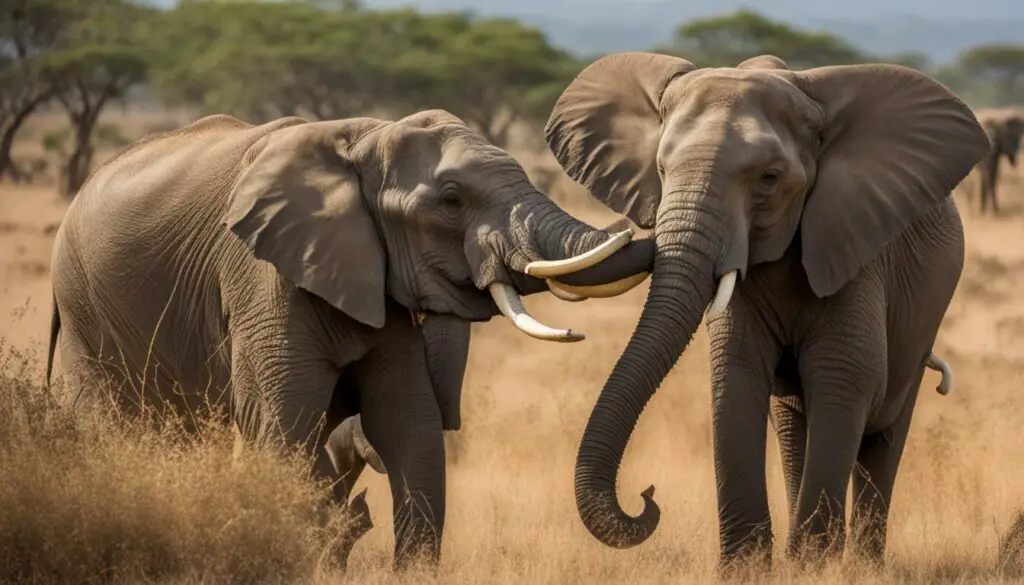When it comes to elephant communication, these majestic creatures have a lot to say. From vocal calls to non-vocal gestures, elephants have a complex system of interaction that allows them to express their needs, emotions, and intentions to their fellow herd members. In this article, we will explore the fascinating world of elephant communication and delve into the various methods they use to communicate with each other in the wild.
But first, let’s take a moment to appreciate the incredible diversity of vocalizations and sounds that elephants use to communicate. From deep trumpets to gentle rumbles, their vocal repertoire is vast and varied. These vocalizations, along with visual and tactile signals, allow elephants to coordinate movements, reconcile differences, attract mates, and reinforce their family bonds.
So, whether it’s through their powerful vocal calls or their subtle body language, elephants have developed an intricate language of their own. Join us as we unravel the mysteries of elephant communication and discover the secrets of how these magnificent creatures talk to each other in the wild.
Vocal Calls: The Language of Elephants
Elephants, with their immense size and social nature, have developed a sophisticated system of communication that involves both vocal and non-vocal methods. Vocal calls, in particular, play a crucial role in the communication repertoire of these majestic creatures. From deep growls to trumpets and cries, elephants utilize various vocalizations to convey messages within their herd and beyond.
One of the most common vocalizations among elephants is the deep growling or rumbling noise. Some researchers believe that these growls may have individual signatures, allowing elephants to recognize one another by their unique calls. Alongside growls, elephants produce a range of other vocal sounds, each carrying a distinct meaning. These sounds can be soft, abrasive, low-pitched, or shrilling, depending on the intended message.
In addition to audible vocalizations, elephants also employ infrasonic calls, which are below the level of human hearing. These calls can travel for miles through forests, enabling elephants to communicate effectively over long distances. Infrasound serves a vital purpose in coordinating movements within the herd, attracting mates, and warning of potential dangers. It gives elephants the ability to connect with one another even when they may be physically distant.
Table: Types of Elephant Vocalizations
| Vocalization | Description |
|---|---|
| Growls | Deep, rumbling noises with potential individual signatures |
| Trumpets | Loud, high-pitched calls often associated with excitement or alarm |
| Cries | Distinct vocalizations expressing various emotions or needs |
| Roars | Loud, powerful vocalizations used for asserting dominance |
| Snorts | Short, forceful exhalations used to express dissatisfaction or irritation |
| Groans | Low, prolonged vocalizations often associated with distress or pain |
The language of elephants goes beyond what we can perceive with our own ears. Through their vocal calls, elephants build a complex network of communication that allows them to navigate their social interactions, express emotions, and ensure the welfare of their herd. Understanding these vocalizations is a window into the remarkable world of these intelligent and social creatures.
Non-Vocal Communication: The Power of Touch and Body Language
In addition to vocal calls, elephants communicate through non-vocal methods, using their remarkable sense of touch and body language. One of their most iconic features is their trunk, which they use to touch, caress, and explore their surroundings, including other elephants. Through gentle trunk interactions, elephants establish and reinforce social bonds, conveying various messages and emotions to one another.
Elephants also utilize their trunks to communicate their interest in death by touching and smelling bones. This behavior is not only a means of exploration but also a way for elephants to show respect and acknowledge the deceased. Their trunks serve as a powerful tool for tactile interaction, allowing them to interact with their environment, fellow elephants, and even humans.
In addition to touch, elephants use body language as a form of non-vocal communication. They can raise their heads, spread their ears, shake their heads, throw dust and vegetation, and raise their trunks, all of which convey different messages and emotions. These visual displays are crucial during social interactions and can provide valuable insight into an elephant’s intentions, emotional state, and overall well-being.
Table: Elephant Trunk Gestures
| Gestures | Meaning |
|---|---|
| Trunk raised in the air | Alertness or curiosity |
| Trunk wrapped around another elephant | Bonding or affection |
| Trunk touching another elephant’s face | Greeting or reassurance |
| Trunk held loosely | Relaxed or content |
Understanding the intricacies of elephant body language and trunk gestures provides unique insights into their social interactions and emotional lives. By observing and studying these non-vocal communication methods, researchers and conservationists can gain a deeper understanding of how elephants form and maintain their complex social structures and relationships.

Infrasound Communication: Messages Beyond Human Hearing
Elephants have a remarkable ability to communicate using infrasound, which is sound waves that are below the threshold of human hearing. These low-frequency calls enable elephants to convey messages and information over long distances, making it a vital aspect of their communication repertoire. Infrasound calls have been found to play a crucial role in various aspects of elephant communication, including finding mates, reuniting with family members, and warning of potential dangers.
Research on elephant infrasound communication has provided valuable insights into their complex social dynamics. Scientists have discovered that males use infrasonic calls to locate females for breeding, allowing them to establish and maintain reproductive relationships. Additionally, infrasound communication helps elephants coordinate protective behaviors within the herd, ensuring the safety and well-being of the entire group.
Infrasound communication in elephants is an intriguing area of study that continues to unveil the intricate ways in which these magnificent creatures interact and communicate with one another. By delving into the world of infrasound, researchers gain a deeper understanding of elephant behavior and enhance conservation efforts to protect these intelligent and social animals.
Seismic Communication: Feeling the Earth’s Vibrations
Elephants possess a unique ability to communicate through seismic vibrations, which are vibrations produced by impacts on the earth’s surface or acoustical waves that travel through it. They rely on their leg and shoulder bones to detect and transmit these signals to their middle ear. When detecting seismic signals, elephants may exhibit a freezing behavior, leaning forward and putting more weight on their front feet. This remarkable form of communication serves various purposes, including the communication of alarm calls to signal danger from predators.
Seismic communication allows elephants to alert their family group of potential threats, prompting them to enter a defensive posture and pack together for safety. Through these seismic vibrations, elephants effectively convey information about the presence of predators or other danger, enabling rapid coordinated responses within the herd. This form of communication has evolved as a crucial survival strategy, enhancing their ability to navigate their environment and protect themselves against potential threats.
Research has shown that seismic waveforms produced by locomotion or vocalizations can travel over long distances, allowing elephants to communicate effectively within their habitat. By sensing and interpreting these seismic vibrations, elephants are able to maintain social connections and coordinate group movements, ensuring the safety and well-being of the entire herd. Seismic communication further highlights the complexity and sophistication of elephant communication methods, contributing to our understanding of their behaviors and social dynamics.
Overall, seismic communication plays a vital role in the intricate web of elephant communication. By utilizing this unique ability to detect and respond to seismic vibrations, elephants enhance their communication capabilities, providing valuable insights into their social interactions, group dynamics, and adaptive behaviors.
Conclusion
Elephants possess a remarkable communication system that encompasses various methods and signals. Their communication is vital for securing defense, coordinating movements within the herd, expressing emotions, attracting mates, and maintaining social bonds. Through a combination of vocal calls, non-vocal communication, infrasound communication, and seismic communication, elephants effectively interact with their environment and each other.
Elephants have a diverse range of vocalizations, including deep growls, trumpets, cries, and roars. These vocal calls serve different purposes, such as caring for calves, reconciling disagreements, and warning of potential dangers. Additionally, elephants utilize non-vocal communication methods through touch and body language, using their trunks to caress and explore objects, convey messages, and reinforce social bonds.
Infrasound communication enables elephants to send messages over long distances, using low-frequency sound below 20 Hz. This form of communication plays a significant role in various aspects of their lives, from finding breeding partners to reuniting with family members and warning of predators. Moreover, elephants have the extraordinary ability to detect and respond to seismic vibrations, which enhances their communication capabilities and allows them to communicate effectively within their habitat.
Studying elephant communication provides valuable insights into their social interactions, behaviors, and social dynamics. It allows us to better understand these magnificent creatures and appreciate the complexity of their communication methods. By delving deeper into their world, we can further protect and conserve these intelligent and socially sophisticated animals.
What Are the Different Sounds and Communication Methods That Elephants Use in the Wild?
Elephants’ sounds and communication methods are unique. Through low-frequency rumbles, they can communicate over long distances, allowing herds to stay connected. Trumpeting is another method used to express excitement, fear, or aggression. Visual cues such as ear flapping and tail movements also play a role in their communication. These intricate methods help elephants maintain social bonds and navigate their wild environment effectively.
FAQ
How do elephants communicate with each other in the wild?
Elephants communicate through a complex system that includes vocal calls, non-vocal communication, infrasound, and seismic vibrations.
What are vocal calls and how do elephants use them for communication?
Vocal calls are sounds produced by elephants, such as trumpets, cries, and growls. They use vocal calls to coordinate movements, attract mates, and warn of potential dangers.
How do elephants communicate through non-vocal methods?
Elephants use touch and body language, particularly through their trunks, to communicate with each other. They touch and caress to maintain social bonds and convey messages.
What is infrasound communication and how do elephants use it?
Infrasound communication is low-frequency sound below the level of human hearing. Elephants use infrasonic calls to send messages and warnings over long distances.
How do elephants communicate through seismic vibrations?
Elephants can detect and respond to seismic vibrations through their leg and shoulder bones. This allows them to communicate alarm calls and coordinate defensive behaviors.
What role does communication play in elephant social interactions?
Communication is crucial for elephants to secure their defense, coordinate group movements, express emotions, attract mates, and maintain social bonds.
Why is studying elephant communication important?
Studying elephant communication provides valuable insights into their behaviors and social dynamics, helping us better understand these fascinating creatures.











